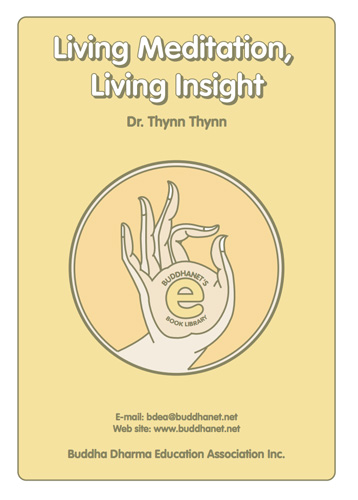 Top rated - eBook Library Top rated - eBook Library |

4nobltru.pdfThe Four Noble Truths19546 viewsThis booklet was compiled and edited from talks given by Venerable Ajahn Sumedho on the teaching of the Buddha: that the unhappiness of humanity can be overcome through spiritual means. The teaching is conveyed through the Buddha's Four Noble Truths, first expounded in 528 BC in the Deer Park at Sarnath near Varanasi, India and kept alive in the Buddhist world ever since.    
(71 votes)
|
|

becoming1.pdfBecoming Your Own Therapist6582 viewsLord Buddha's timeless teachings are as universally relevant today as they were when they were first given, over 2,500 years ago, as Lama explains in these three general talks on the philosophy, psychology and practice of Buddhism. Although called lectures, these talks are not intended to be didactic, but rather for us to use as a mirror for our minds, to allow us to look beyond the words, find ourselves, and become our own psychologist. Each lecture is followed by an informative question and answer session    
(16 votes)
|
|

gates_of_chan.pdfThe Gates of Ch'an Buddhism4264 viewsVenerable Jing Hui
Bodhidharma's Gate: Ch'an (Zen) in fact is an impregnable fortress, without a gate to enter. Suppose there is really a gate, that gate would simply be a method of training to be taken up in the Ch'an tradition. That is why when a monk asked Master Zhao Zhou(778-897: "Has a dog Buddha-nature or not?" Master Zhao Zhou retorted: "Wu". Later on,this Gongan (koan) formed part of a specific approach in the Ch'an School. The author,Venerable Jing Hui is a Ch'an Master and a vice-president of the Buddhist Association of China.    
(10 votes)
|
|

dmind-wmind.pdfDharma Mind, Worldly Mind4791 viewsThe first part of the book tells us what we need to put in place for complete Dharma practice - the Eightfold Path, going for refuge, and the Bodhisattva spirit. In the second half the book shows us how to turn those requisites into a genuine living practice that embraces the whole of our life thus surely leading to the profound transformation that we all desire.    
(10 votes)
|
|

01Practicing_Vipassana.pdfPracticing Vipassana Meditation5373 viewsMany people all over the world are now practicing the Buddhist meditation known as Vipassana or Insight Meditation. Western psychotherapies have taken it up as ‘mindfulness’ as well as ordinary people who have found it beneficial in coping with the stresses and strains of modern life. While many are increasingly taking time out to attend retreats in Vipassana meditation centres. So this series of text will take you the basic practice.    
(7 votes)
|
|

damapada.pdfThe Dhammapada, a Translation3038 viewsVen. Thanissaro, Bhikkhu
The Dhammapada has long been recognized as one of the masterpieces of early Buddhist literature. Only more recently have scholars realized that it is also one of the early masterpieces of the Indian tradition of Kavya, or belles lettres. This translation is an attempt to render the verses into English in a way that does justice to both of the traditions to which the text belongs. Although it is tempting to view these traditions as distinct, dealing with form (Kavya) and content (Buddhism), the ideals of Kavya aimed at combining form and content into a seamless whole.    
(7 votes)
|
|

livngmed.pdfLiving Meditation, Living Insight4917 viewsI wrote this book to encourage practitioners learning to meditate in daily life. In this sense, the articles are presented as a hands-on or, more accurately, a minds-on training manual. Although I discuss meditation in general, the real focus is on how the Dhamma brings us into spontaneous, wholesome and creative living. My objective in presenting the articles is to help the aspirant build up a solid foundation of mindfulness as a way of life rather than as a practice separated from daily living - Dr. Thynn Thynn.    
(18 votes)
|
|

artliv12.pdfThe Art of Living17238 viewsThe Art of Living with Ven. Master Chin Kung, a Master of the Pure Land School of Buddhism. The Art of Living has chapters on: The Education of Buddha Shakyamuni, our Original Teacher; The Four Kinds of Buddhism Today; How Homemakers Can Cultivate the Bodhisattva Way in Daily Life, and an excellent Question and Answer section. Included is a glossary and a contact list of Ven. Master Chin Kung's teaching centres around the world.    
(15 votes)
|
|

buddhism_a_laymans_guide_to_life.pdfBuddhism, A Layman's Guide to Life3062 views    
(4 votes)
|
|

73_knowledges.pdfSeventy-Three Kinds of Knowledge2975 viewsVen. Nyanadassana, Bhikkhu
Since these knowledges are, as a Summary, very briefly stated,the present translation has explanatory notes in order to facilitate the reader understand them, at least intellectually, more easily. These explanations are based on the Pañisambhid -magga, the Visuddhi-magga and their corresponding Commentaries, and their references are clearly distinguished. The translation of each knowledge
is repeated in the Notes, in bold, for convenient reading.     
(4 votes)
|
|
| 290 files on 29 page(s) |
 |
 |
 |
19 |  |
 |
 |
|
